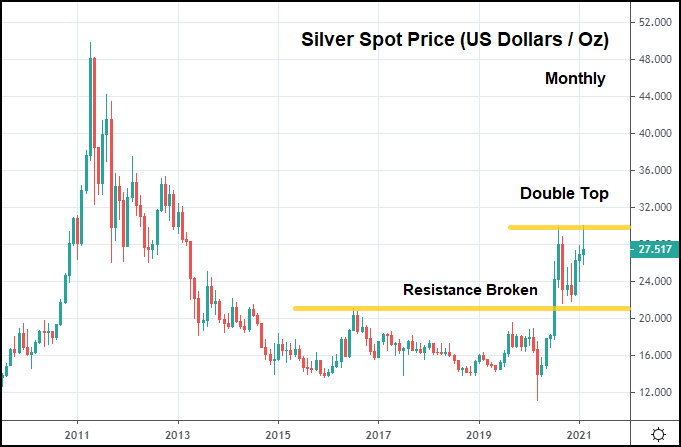The market’s closed in observance of Washington’s birthday, and while American equities rest, silver’s abuzz with news of another short squeeze.
It was less than a week ago when silver-backed ETFs announced that 85% of London’s silver supply was accounted for. ETFs, like the gargantuan iShares Silver Trust (NYSE: SLV), source almost all their physical silver from the London Bullion Market Association’s (LBMA) vaults, where silver bars are growing increasingly scarce.
That’s created some controversy among precious metals investors. If silver stockpilers continue to snap-up London’s supply, SLV (and others) may not be able to meet the demands of buyers. Bullion banks have long been accused of suppressing the physical price of silver via the paper markets, where ETFs like SLV exist.
The evidence of that manipulation can be seen with one ounce silver American Eagle coins, which are available for a premium of $10.49/oz. above spot. It’s a huge disparity given that silver’s current spot price hovers around $27.50 per ounce.
The gap between paper and physical silver has existed for decades, now, but it hasn’t been this large before. A short squeeze attempt from two weeks ago initially caused the physical premium to spike.
And if the LBMA vaults run out of inventory, it’s likely to get even worse. In anticipation of such a scenario unfolding, SLV made changes to its prospectus on February 5th, detailing what would happen to the ETF should physical silver truly sell out.
“The demand for silver may temporarily exceed available supply that is acceptable for delivery to the Trust, which may adversely affect an investment in the Shares,” read the new prospectus.
“It is possible that Authorized Participants may be unable to acquire sufficient silver that is acceptable for delivery to the Trust for the issuance of new Baskets due to a limited then-available supply coupled with a surge in demand for the Shares.”
The edit to the prospectus concluded, stating that “the trading price of the Shares has recently been, and could potentially continue to be, volatile.”
In other words, if investors continue buying paper silver, SLV will need to buy more physical. If LBMA has no more silver to sell, SLV can’t issue new baskets.
The gap between physical and paper silver could quickly narrow as a result. Contributing to this problem is the fact that central banks don’t hold physical silver like they do gold. So, silver ETFs can’t even be loaned any silver by central banks in a time of unprecedented demand – something that may be quickly approaching.
You’d think silver’s (paper) spot price would be soaring in response to the recent physical silver shortage.
But that simply hasn’t been the case.

Yes, spot silver is up in recent months after breaking past resistance at the 2016 high. However, it’s still trading well below the 2011 all-time high. If anything, spot silver seems to be starting a longer-term uptrend after finishing 2020 with a bang.
And if LBMA runs out of physical, spot silver could quickly surpass resistance at its recent double top.
It all depends on what happens from here, though. Without sustained buying in London, the silver short squeeze could fizzle out.
But if silver’s recent trend is any indicator, the run on physical should only intensify, pushing the above spot premium higher and higher.
And, eventually, it should also force paper silver to rapidly close the distance between the two markets.









This is a great article to consider silver’s future, but it completely ignores the elephant in the room: There is not a global silver shortage. There is expected to be a physical surplus in 2021, and the manufacturing demand that *will* make silver skyrocket isn’t coming for another five to ten years.